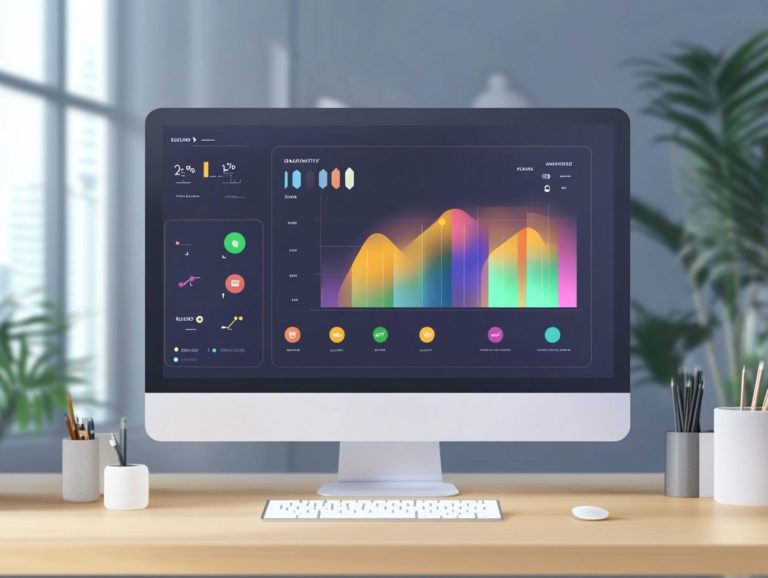Performance Management Tools: Overcoming Resistance
In today s fast-paced work environment, utilizing performance management tools is essential for fostering employee engagement and boosting productivity.
However, many organizations encounter resistance when introducing these tools. This article delves into the common reasons behind this pushback, emphasizes the numerous benefits these tools can provide, and offers insights into selecting and successfully implementing the right solutions.
It also tackles challenges that may arise during the process and shares best practices to ensure these tools yield maximum impact. Learn how to create an exciting culture of performance improvement that everyone will love!
Contents
- Key Takeaways:
- Understanding Resistance to Performance Management Tools
- Benefits of Performance Management Tools
- Choosing the Right Performance Management Tool
- Implementing Performance Management Tools Successfully
- Overcoming Resistance to Performance Management Tools
- Best Practices for Using Performance Management Tools
- Frequently Asked Questions
- What are performance management tools and why are they important?
- What are some common reasons for resistance towards performance management tools?
- How can organizations overcome resistance towards tools to manage employee performance?
- What are some key benefits of using tools to manage employee performance?
- What types of tools to manage employee performance are available?
- How can organizations ensure successful implementation and adoption of these tools?
Key Takeaways:

- Resistance to performance management tools is a common challenge, but understanding the reasons behind it can help overcome it.
- Implementing the right performance management tool can lead to improved employee performance and engagement.
- To successfully implement performance management tools, consider factors like company culture and employee needs, and have a clear implementation strategy in place.
Understanding Resistance to Performance Management Tools
Understanding the resistance to performance management tools is essential for any organization aiming to implement effective performance management processes. This resistance often arises from employees’ fears, a lack of transparency, or previous negative experiences. These issues can impede the adoption of useful data and collaborative decision-making.
Acknowledging these challenges is the crucial first step in overcoming resistance. This awareness allows you to align goals with employee development and career aspirations, while fostering a culture of continuous support. By examining how industry leaders like Adobe and General Electric have successfully navigated these issues, you can enhance workforce engagement and optimize your revenue cycle performance.
Common Reasons for Resistance
Common reasons for resisting performance management tools often stem from a lack of understanding regarding performance management processes and inadequate training programs. This confusion can lead to disengagement among employees.
Fear of performance assessments also plays a significant role in this hesitation. You might worry about negative evaluations that could hinder your career progression. If there s a disconnect between these tools and the broader organizational strategy, feelings of disillusionment can deepen. For instance, if you perceive that performance metrics aren t aligned with the company s goals, they might seem irrelevant or even punitive.
However, by implementing comprehensive training programs that clearly outline the objectives and benefits of these tools, organizations can transform resistance into engagement. When you are well-informed and can see how your contributions directly connect to overarching goals, you are likely to become more invested in your performance. This, in turn, fosters a significantly improved company culture.
Benefits of Performance Management Tools
Performance management tools present a wealth of advantages that can elevate your organization to new heights. They help set better goals, refine performance appraisals, and empower you to leverage useful data for more effective employee development.
By integrating these tools, you can inspire greater engagement and align individual goals with the overarching objectives of your organization. This alignment ultimately boosts both productivity and morale.
These tools also offer continuous support for your employees, enabling them to monitor their career aspirations and successfully reach their professional milestones.
To learn more about performance management tools, feel free to explore further or contact us for more information!
Improving Employee Performance and Engagement
Improving employee performance and engagement is a significant advantage of utilizing performance management tools. These tools facilitate effective feedback systems and establish clear performance metrics, creating a framework for success.
Adopting these systems fosters a culture of continuous feedback. This helps employees recognize their strengths and identify areas for growth.
Implementing regular check-ins and performance reviews ensures that your team feels supported and aligned with their individual goals.
Utilizing performance metrics clarifies expectations and highlights progress. This motivates your teams to strive for excellence. When employees receive constructive feedback consistently, they are more likely to take ownership of their development. This results in higher engagement levels and improved overall performance.
Choosing the Right Performance Management Tool

Selecting the right performance management tool is critical. It demands your thoughtful consideration of several key factors, such as goal alignment, user-friendliness, and the capability to understand the people involved.
The ideal performance management system addresses the unique needs of your organization while fostering transparency and continuous support. Carefully evaluating these elements ensures that the tool you choose seamlessly integrates with your performance management processes and enhances employee development and engagement.
Factors to Consider
When selecting a performance management tool, it’s essential to consider key factors: goal alignment, the ability to integrate training programs, and the robustness of feedback systems.
Scalability is paramount; you need a solution that can grow alongside your organization. It should accommodate an expanding workforce without sacrificing performance. Ease of integration with your existing systems significantly reduces deployment time and minimizes disruptions to daily operations.
Leading companies often prioritize tools that connect seamlessly with their current HR platforms. This ensures a smoother transition and an enhanced user experience.
Don’t miss out on the power of user training it’s key to unlocking your team’s potential! Organizations that focus on comprehensive training programs empower their teams to leverage these tools effectively. This ultimately enhances overall productivity and achieves strategic objectives.
Implementing Performance Management Tools Successfully
Successfully implementing performance management tools demands a structured approach. This involves integrating essential changes, providing ongoing support, and employing effective change management strategies.
Prioritize clear communication and comprehensive training to ensure every employee grasps the benefits and functionalities of these tools. By adhering to key steps in the implementation process, you cultivate a culture of performance and accountability throughout the organization.
Key Steps and Strategies
Key steps and strategies for successfully implementing performance management tools include setting clear objectives, providing adequate training, and fostering an environment that encourages organizational change.
Start by taking the time to define specific, measurable goals that align with your overarching mission. This clarity serves as a beacon for your subsequent efforts.
Training goes beyond equipping your team with the necessary tools; it s about cultivating a mindset that embraces continuous improvement. By creating a culture that welcomes feedback, you can identify potential roadblocks early on. This allows for timely adjustments.
A common pitfall is overlooking the importance of ongoing support. Counteract this risk by implementing regular check-ins and refresher courses, as they can prove invaluable.
Ultimately, integrating performance management tools should transcend mere compliance. It should drive meaningful change that enhances both productivity and morale across the organization.
Overcoming Resistance to Performance Management Tools
Overcoming resistance to performance management tools is crucial to ensuring your success in elevating employee engagement and improving effectiveness. By employing proactive resistance management techniques, you thoughtfully address any concerns and fears your employees may have regarding change. Implementing performance management tools: strategies for success through well-designed detailed training sessions will further ease the transition.
Actively involving employees in the decision-making process and transparently communicating the benefits of these tools cultivates a positive environment that minimizes resistance. This approach enhances overall engagement and ensures that your organization can harness its full potential for performance management initiatives.
Addressing Common Challenges and Concerns

Addressing common challenges and concerns associated with performance management tools is essential for successful implementation and adoption within your organization.
Fear of negative feedback often arises during the performance evaluation process. This apprehension can stem from a lack of confidence in the tools available, making employees hesitant to fully embrace their capabilities.
To alleviate these concerns, it’s vital to provide ongoing support, supplemented by detailed training sessions. These initiatives should familiarize employees with the tools and highlight their advantages.
Fostering transparent communication creates an environment where everyone feels safe discussing fears and experiences. This ultimately encourages a more open and constructive approach to performance management.
Best Practices for Using Performance Management Tools
By adopting best practices with performance management tools, you’ll see a real boost in effectiveness, fostering employee development and ensuring that goals align seamlessly across your organization.
Following these proven strategies cultivates a culture of accountability and continuous improvement, ultimately enhancing workforce engagement and driving superior performance outcomes.
Tips for Maximizing Effectiveness and Results
To truly maximize the effectiveness of performance management tools, prioritize setting clear performance metrics, offering ongoing support, and ensuring alignment with your organization’s strategies.
Establishing precise Key Performance Indicators (KPIs), which are measurable values demonstrating how effectively an organization is achieving key business objectives, tailored to specific roles creates a benchmark that effectively guides employee efforts. Leaders must communicate these expectations regularly, ensuring that team members understand their requirements and recognize how their goals contribute to the overall mission.
Fostering a culture of continuous feedback encourages employees to share insights and experiences. This open dialogue addresses concerns and boosts morale, ultimately leading to improved performance and productivity throughout the organization.
Frequently Asked Questions
What are performance management tools and why are they important?
Performance management tools are software or systems designed to help organizations monitor, analyze, and improve employee performance. They are important as they provide valuable data and insights that help companies make informed decisions about their employees and drive business success.
What are some common reasons for resistance towards performance management tools?

Resistance towards performance management tools can stem from fear of change, lack of understanding, concerns over privacy, and the feeling that the tools are used to monitor and control rather than develop and support employees.
Call to Action: Implement these strategies to enhance your performance management tools and foster a more engaged workforce!
How can organizations overcome resistance towards tools to manage employee performance?
Organizations can overcome resistance by involving employees in the selection and implementation process. Providing training and support, addressing concerns, and emphasizing the benefits for both employees and the company are also essential.
What are some key benefits of using tools to manage employee performance?
Tools to manage employee performance help organizations quickly identify top performers. They also track progress, set goals, provide timely feedback, and foster a culture of continuous improvement.
What types of tools to manage employee performance are available?
Various tools are available, including software for performance reviews and goal tracking. These tools serve different purposes and can be tailored to fit the needs of different organizations.
How can organizations ensure successful implementation and adoption of these tools?
To successfully implement these tools, organizations must actively engage their teams. Clear communication about the purpose and benefits, along with ongoing training and support, is crucial.




